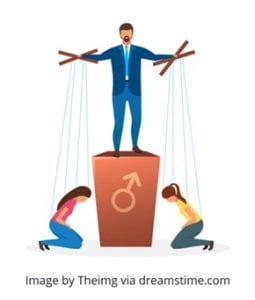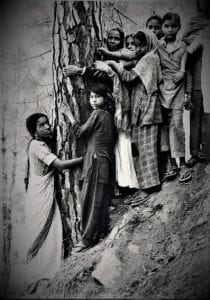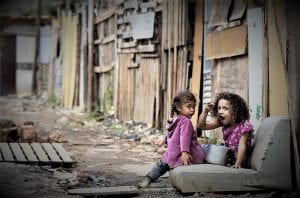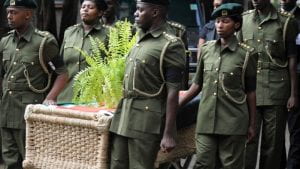
The connection between the oppression of women and the oppression of nature is a complex and multifaceted issue that has gained increasing attention in recent years. A common argument among feminists is that societal structures and justifications rely on categorical or dualistic hierarchies, which are used to perpetuate patriarchy (Hobgood-Oster, 2-3). These systems that have historically subjugated women have also contributed to the degradation and exploitation of the natural world. Feminists also argue that the same values that promote domination and control over women also promote exploitation and destruction of the environment. This is because both women and nature are seen as passive resources to be exploited for the benefit of men, without regard for their intrinsic value or autonomy.

The Chipko Movement in India during the 1970s demonstrated the connection between the oppression of women and the oppression of nature, as women came together to protect their environment and livelihoods against government and corporate attempts to destroy forests for profit. The movement began when women spontaneously embraced trees in response to the government’s decision to allot forest area to a sports goods company while denying locals the right to use wood for making agricultural tools.

By protecting forests, women demonstrated their commitment to preserving resources that were crucial for their families and communities, highlighting the need for women’s voices to be heard in decision-making processes related to the environment. The success of the movement in achieving a 15-year ban on green felling in the Himalayan forests of Uttar Pradesh is a testament to the power of grassroots organizing and community activism, which has inspired environmental activism in India and beyond, while generating pressure for a more sustainable and equitable approach to resource management.
However, at the root of this issue lies the deeper issue of disempowerment, which affects both marginalized women and the environment. Women and nature are both seen as subordinate to men and human society, and their needs and interests are often ignored or dismissed. This has led to a situation where women are disproportionately affected by poverty, violence, and environmental degradation, and where the natural world is being destroyed at an alarming rate.

The disturbing image of nine-year old Paulo Henrique, a Brazilian child who was photographed immersed in a canal filled with garbage serves as a striking example of the destructive consequences of environmental degradation on impoverished communities. The polluted canal and the environmental degradation in Recife is the result of industrialization and urbanization, which prioritize economic growth over environmental protection. The waste and pollution generated by these activities disproportionately affect the poor and marginalized communities who live in close proximity to these industries.
Paulo’s situation of having to collect recyclables in the contaminated water is a poignant reminder of how extreme poverty and economic inequality can lead to environmental collapse. Nonetheless, behind the material deprivations and cultural losses of the marginalized and the poor, lie the deeper issues of disempowerment and environmental degradation. The marginalized communities in Recife are often denied access to basic services like education, healthcare, and sanitation. This perpetuates a cycle of poverty that forces children like Paulo to scavenge for scraps in order to survive.
According to Vice Media Group, many of the 6,500 children who live in the slums in the Arruda and Campina Barreto neighborhoods on Recife’s north side, pick through trash to make a living, just like Paulo does; however, it was only after his image appeared in the press that the local government and international authorities took notice of their plight. In response to the photo and the accompanying article, the government promised to place Paulo, his mother, and her fiancé in a home where they could live (Corrêa, 2014).

Paulo Henrique’s heartbreaking story is not an isolated incident. Paulo’s tragic story is a sad and powerful reminder of the intersectionality of poverty, environmental degradation, and the exploitation of the marginalized. The widespread nature of such activities highlights a systemic problem caused by inadequate waste management policies, weak enforcement, and economic policies that neglect the most vulnerable members of society.
Thousands of children are trapped in similar conditions, living in the slums of Recife and other Brazilian states including Rio de Janeiro, the city of Carnival, Samba, and soccer. What makes their plight worse is that most slums have very narrow streets and are not accessible by larger vehicles, including ambulances and waste management trucks. Slum residents must rely on city workers who make long and often dangerous trips into the slums on bicycles to collect trash that sits on street corners for weeks at a time, waiting for collection. In some remote areas of the slums not even accessible by bicycles, city workers must rappel off embankments to clean out the trash.

Paulo’s story is a compelling example of how different types of oppression against women and marginalized communities intersect with environmental degradation, reinforced by patriarchal values that prescribe the subjugation of these groups to men and the natural environment’s subordination to human domination.
The global reality of impoverished families facing environmental degradation and exploitation serves as a harsh reminder of the urgent need to address the root causes of poverty. The intersectionality of various forms of oppression, including patriarchy and environmental degradation, has further excluded women from decision-making processes related to environmental issues and resulted in the perpetuation of exploitation and adverse effects to the health of both humans and the environment.
To combat this, it is important to acknowledge the interconnectedness of social and environmental issues and continue the shift towards feminism and the fight for women’s right to be included in decision-making processes.
The shift, although gradual, has been made possible by the efforts of women from all walks of life who have worked tirelessly to create a more equitable society. These women’s work on ecofeminism is especially relevant today, as we witness the devastating effects of climate change and environmental degradation on communities across the globe.
One such woman is Ivone Gebara, a Brazilian feminist theologian, philosopher, and writer.

Gebara’s work is primarily concerned with feminist theory and theology, examining the role of women in religion and how patriarchal structures shape their experiences. Her contributions to promoting ecofeminism, a term not found in Brazilian dictionaries (Gerbara 93), have been vital.
Moreover, she is a passionate advocate for social justice and human rights, speaking out against poverty, racism, and discrimination. Her work highlights the need to view these issues as interconnected and suggests that meaningful progress in the feminist movement requires addressing the systemic issues that lead to gender inequality and environmental destruction.
Gebara’s work has had a significant impact in Brazil, where she has played an important role in inspiring a new generation of feminist theologians and writers to fight for the rights of poor and marginalized women who suffer daily from the consequences of a patriarchal society, compounded by a global system that places a capitalist domination on nature and human relationships. This system enslaves and holds people hostage everywhere, especially women who are forced to live their lives as “jailed” prisoners with no means to choose alternatives for a better life (Gebara 96).

Wangari Maathai is another remarkable woman who dedicated a life to shifting the feminist needle toward environmental healing. Maathai achieved several notable firsts during her lifetime, including being the first African woman to receive the Nobel Peace Prize and being the first female scholar from East and Central Africa to take a doctorate (in biology), and the first female professor ever in her home country of Kenya.
Maathai’s dedication to protecting the environment was fundamental to her activism, and she utilized her expertise and knowledge to establish the Green Belt Movement on Earth Day in 1977 in Kenya, with a program to encourage farmers (70% of whom were women) to establish “Green Belts” to prevent soil erosion, provide shade, and create a source of lumber and firewood. She distributed seedlings to rural women and implemented an incentive scheme based on the number of surviving seedlings. As a result of this initiative, over fifteen million trees have been planted, creating income for eighty thousand individuals in Kenya alone. The success of the movement has resulted in its growth to more than thirty African countries, the United States, and Haiti (The Green Belt Movement 2020).
Maathai’s work helped address environmental degradation while also promoting economic empowerment and gender equality. Her impact on the world was widely recognized, and she continues to inspire people around the globe, particularly women and girls who are striving to break down barriers and pursue their goals in male-dominated fields. Her work demonstrates the importance of education, environmental activism, and social justice, and her many firsts serve as a reminder of the potential for positive change that can be achieved by determined individuals.

Wangari Maathai passed away on October 7, 2011.
Kenyan President Mwai Kibaki presided over a state funeral in Nairobi, which marked another historic first moment as Maathai became the first woman and only the third Kenyan to receive this honor. True to her activism and love for the environment until the very end, this remarkable woman who repeatedly risked her life to protect the trees of Kenya and denounced President Daniel Arap Moi’s proposal to erect a sixty-two-story skyscraper in the middle of Nairobi’s largest park (The Green Belt Movement 2020), made it clear that no tree should be cut down to make her coffin. Instead, her body was to be placed in a casket made from natural materials such as hyacinth, papyrus, and bamboo and later cremated (Joselow 2011).
Maathai was a trailblazing environmentalist and fearless advocate for social justice and environmental protection, and her legacy serves as a reminder of the power of grassroots activism and the importance of protecting our planet for future generations.
Works Cited:
Corrêa, T. (2014, January 30). The Brazilian Slum Children Who Are Literally Swimming in Garbage. https://www.vice.com/en/article/kwpwja/the-brazilian-slum-children-who-are-literally-swimming-in-garbage-0000197-v21n1
Cstraight Media – http://www.cstraight.com. (n.d.). Speak Truth to Power | The Green Belt Movement. http://www.greenbeltmovement.org/wangari-maathai/key-speeches-and-articles/speak-truth-to-power
Gebara, I. (2003). “Ecofeminism: A Latin American Perspective.” Cross Currents. https://tinyurl.com/4jkwbjbd
Hobgood-Oster, Laura. “Ecofeminism: Historic and International Evolution.” Encyclopedia of Religion and Nature, edited by Bron Taylor, Continuum, London & New York , 2005, pp. 533–539, http://www.religionandnature.com/ern/sample/Hobgood-Oster–Ecofeminism.pdf.
Joselow, G. (2011, October 8). Kenya Says Final Goodbye to Wangari Maathai. VOA. https://www.voanews.com/a/hundreds-attend-state-funeral-of-african-nobel-peace-laureate-131381873/146347.html

My brother suggested I would possibly like this blog.
He was entirely right. This publish actually made my
day. You cann’t imagine simply how so much time I had spent for this info!
Thank you!
Hi my loved one! I wish to say that this article is awesome, great written and come with approximately all significant infos.
I’d like to see more posts like this .
Hi Rose! I really enjoyed reading your blog post. One pattern that I saw in your post is the repetition of relation between environmental degradation and the oppression of women through exploitations for economic gain. I think the 2 are connected a lot more than we may be able to realize. The environment is degraded through the continued use of fossil fuels, pollutants in the air, and the ignoring climate change. Especially in the US this is done to further advance both corporate and political agenda. For example, Representative Joe Manchin has made millions from the coal industry so of course he is going to keep that industry and benefitting it in mind when legislating. So in the wake of Manchin’s and the coal industry’s economic gain, the earth and the environment will be subject to degradation. Women are also exploited for economic gain through advertising, as we explored earlier this semester, and also through exploitation of the environment for economic gain. For example, the lack of investment in clean and renewable energy puts women and girls at special health risks like breast cancer and ovarian diseases. So just like economic and government leaders are willing to put the environment at risk for profit, they are willing to put women at risk for profit.
Hi Brooke,
Environmental degradation and the oppression of women through economic exploitation are interconnected issues, and it is unfortunately common for corporate and political interests to prioritize short-term economic gains over long-term environmental sustainability and social justice. As you mentioned, the use of fossil fuels and pollutants in the air contribute to environmental degradation and climate change, which disproportionately affect marginalized communities, including women. In addition, the exploitation of women for economic gain through advertising and other industries is also a form of environmental degradation, as it perpetuates harmful gender stereotypes and reinforces harmful societal norms; our “Vegetarian Ecofeminism” assignment was very insightful and eye opening to me.
Investing in clean and renewable energy can have a positive impact not only on the environment but also on the health and well-being of women and girls. It’s essential that we prioritize sustainable development and social justice in all aspects of our society and resist the temptation to prioritize short-term economic gains over long-term sustainability. And we must also continue to advocate for systemic change that addresses these issues and uplifts marginalized communities.
Hi Rose – I really liked your quote at the end of your essay where you state that “Maathai was a trailblazing environmentalist and fearless advocate for social justice and environmental protection.” I was intrigued by her, and her work as well, so I looked into her life, a little more to learn about the different things that she did. I found out she served as the president of the Economic, Social and Cultural Council in Africa for a short time; a role which seems to me that came naturally after her years of helping women with the Greenbelt movement. I say this, because this Council was designed to give smaller organizations a voice within the government. I love that she was still providing a voice for those that may not have had one otherwise, even towards the end of her life. I completely missed that she also won the Nobel Peace prize in 2004! The Committee (who awarded her the prize) stated at the time: “She has taken a holistic approach to sustainable development that embraces democracy, human rights and women’s rights in particular.” I had some trouble finding a link to text or video of her speech, but I am including a link below to a photo gallery of Maathai accepting her award.
I was sad to read that the oppression she faced in her activist life seemed to bleed into her personal one as well. Her husband was quoted to have said that she was unable to be controlled and she was ‘too strong-minded’, so he divorced her. Sadder still, we continue to hear men speak of woman this way even today. I am grateful for her trailblazing the way for women today, to continue to advocate for ourselves and fight for social justice.
Nobel Prize gallery:
https://www.nobelprize.org/prizes/peace/2004/maathai/photo-gallery/
other sources used:
http://www.greenbeltmovement.org/wangari-maathai/the-nobel-peace-prize
https://en.wikipedia.org/wiki/Wangari_Maathai#1977–1979:_Personal_problems
Hi Amanda,
Maathai was indeed a remarkable individual and an amazing advocate for the environment and social justice. Her ability to create grassroots movements like the Green Belt Movement and bring attention to environmental issues in Kenya was truly inspiring. Her work with the Economic, Social and Cultural Council in Africa was an extension of her dedication to empowering marginalized groups, and it’s incredible that she continued to do this until the end of her life.
It’s unfortunate that Maathai faced oppression not only in her activist life but also in her personal life. Her husband’s comments about her being “too strong-minded” and difficult to control highlights the systemic sexism that exists in our society. However, her ability to persevere and make a significant impact despite these challenges is a testament to her strength and resilience. Her work reminds us that individuals can make a difference, and we should strive to leave a positive impact on the world, no matter how big or small. I have no doubt she will continue to be an inspiration for future generations of women activists…she left a beautiful legacy.
Hi Lizzy,
I am glad you found the first image in my post to be powerful. It truly is a good depiction of how patriarchy operates and the oppression it has exerted on women throughout history. You make a good point about how it often takes something extreme to get people to pay attention and demand change. Unfortunately, it seems like we have a tendency to become complacent until a crisis occurs.
Regarding Paulo’s life, it is hard to say what has happened since that photo was taken, but I agree with you that it is important not to let instances of injustice be used as a way for corporations or the media to simply improve their image without addressing the root cause of the problem. Real change takes sustained effort and commitment from many people.
Wangari Maathai’s quote is very powerful, and I think it highlights the fact that change is not always easy or safe. It can be uncomfortable and even dangerous to stand up for what is right, but it is necessary if we want to make positive changes an move towards a just and equitable world. That said, I also believe that change can happen in smaller, everyday actions. We don’t always have to put our lives at risk to make a positive impact in the world. Every small step counts. 🙂
Hey Rose,
The first image of your post is really powerful and I believe it captures this idea well. A man standing above his subordinates, holding a whip. Wow. I often wonder why it takes something extreme to make others notice and want to begin change. I’m sure if we looked into Paolo’s life, now that years have passed, not much has been done. When images like that are released, I feel as if the media and other large corporate groups use it to make themselves look better. A one time deal, so the people under them believe change is near when we all know it isn’t.
One thing that really struck me while reading about Wangari Maathai, is the final line in her article. “It’s not like I see danger coming, and I feel danger. At this particular moment, I am only seeing one thing—that I am moving in the right direction.” To me this means that there will not be a time for change unless it endangers our lives. To make real change happen, we have to be willing to risk our own well-being. I hate that this is how our world is, but she’s right.